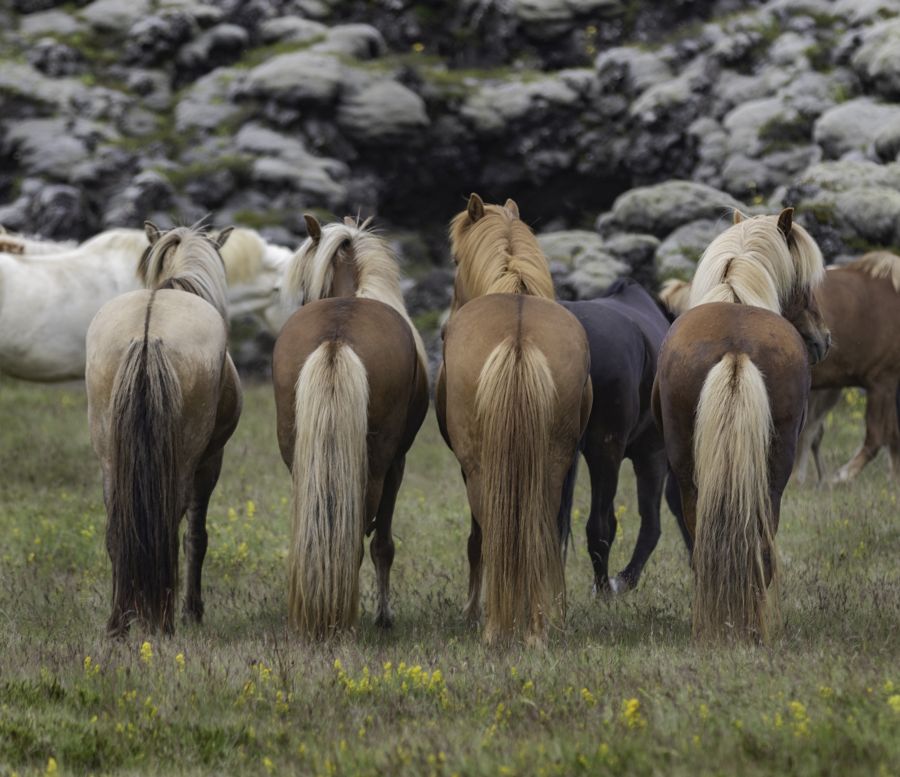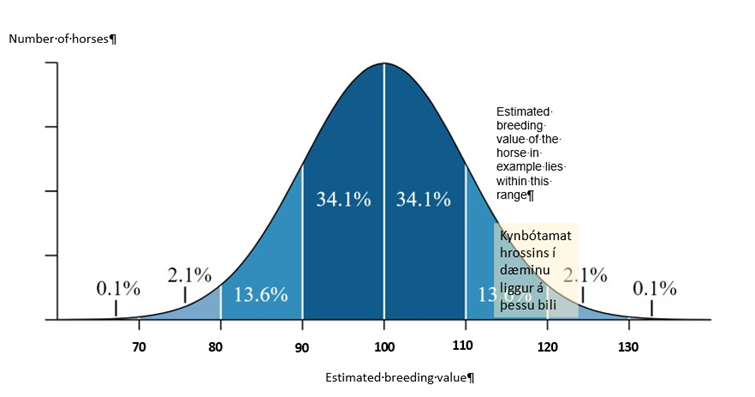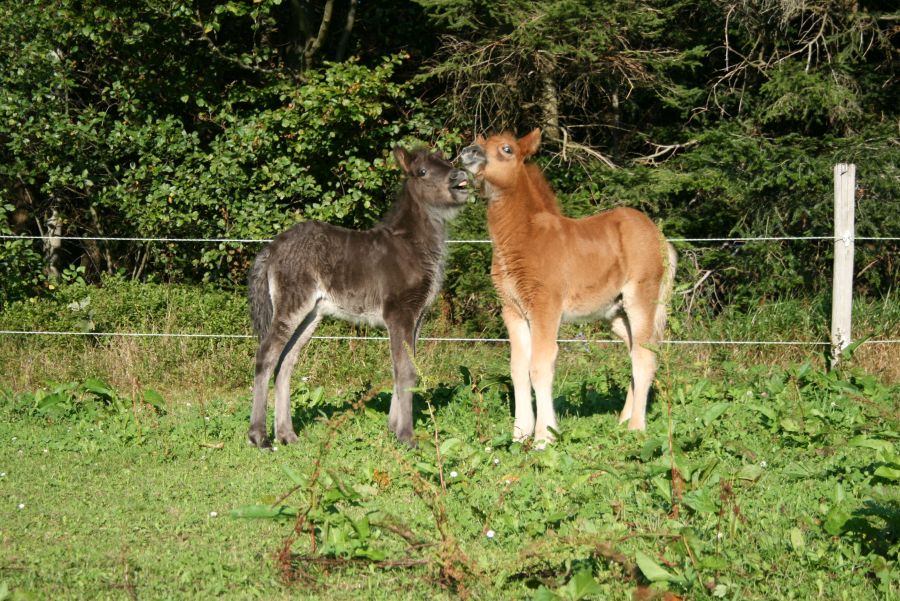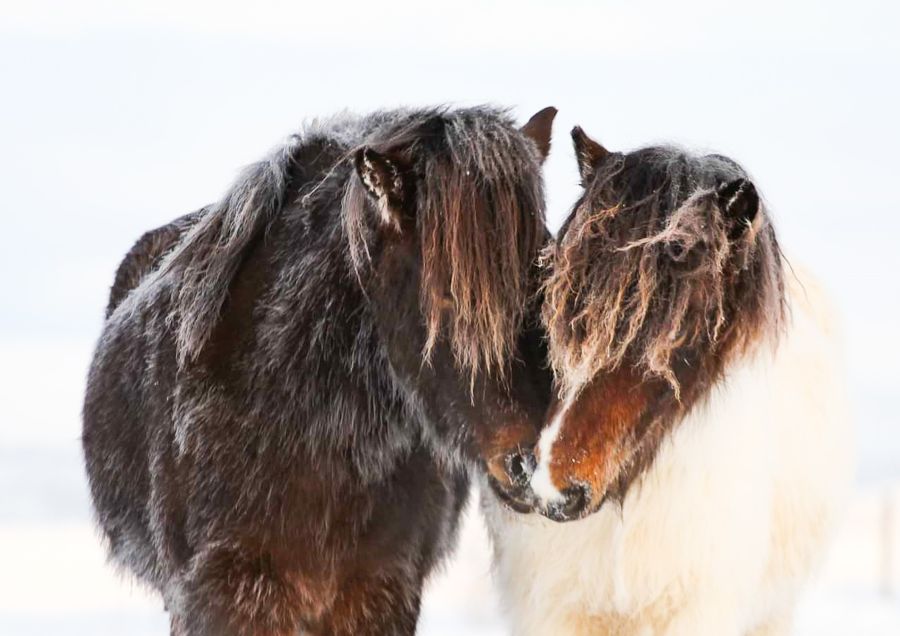BLUP
Generally about BLUP
One of the most important support available for breeders of Icelandic horses are BLUP values, reflecting the breeding value of individual horses. The BLUP (Best Linear Unbiased Prediction) calculations for Icelandic horses are done for the entire population (all registered horses in all countries). It is the Farmers Association in Iceland that is responsible for the calculations and the development of the system.
BLUP is a mathematical method that summits all available information included in the breeding goal of the Icelandic horse from breeding assessments of all horses in the population. It estimates the breeding value of individual horses and ranks them based on their expected contribution to the development of the breed. Approximately, 500.000 horses have calculated BLUP values that are updated every year as new information is added from breeding assessments on a yearly basis.
The scale is set with 100 as the average value and one standard deviation (std) is 10 units. The population of horses is distributed on 6 std (normal distribution), with only a few horses outside of the range of 70-130. The recommendation is not to use individuals for breeding that have a BLUP breeding value below 100, as their contribution is likely to be in a negative direction, compared to the official breeding goal for the breed. In this context it is important to take the accuracy into account, that differs from one horse to another. The more information there is about parents and relatives, the higher the accuracy of the estimation becomes. Accuracy below 60% should be interpreted as relatively uncertain estimation. In general, the higher the accuracy becomes, the lower the std will be. Further information about std and accuracy can be found in WF (www.worldfengur.com).

Photo: Andres Andresson, photo competition 2022
A horse with an estimated breeding value for total score of 118, std of 5 and 87% accuracy means that this horse has true breeding value between 113 and 123 with 87% accuracy. The horse can be considered as being a very good breeding horse as it belongs to approximately 15% best horses of the Icelandic horse population worldwide. In plain words, a pretty accurate prognose of the validity that this individual passes good genes to the next generation of horses.

Distribution of the breeding value for the total population of Icelandic horses. The breeding value of 99,8% of all horses ranges between 70 and 130. The (yellow) box refers to the example mentioned in the text above whereas the connection between the breeding value, std and accuracy is described
Corrections for systematic environmental factors
The BLUP method for estimation of breeding values is a highly reliable and robust method. The BLUP values reflect the individual’s genetic capacity in comparison with all other individuals within the population. All known systematic environmental factors are considered and corrected by the system. The purpose of those corrections is to make the assessments of individual horses comparable between individuals.
Corrections are made for three systematic environmental factors. The factors are age and gender of the horse and the year in which the horse received the highest breeding assessment corrected by age. Concerning the age and the gender of an individuum, these factors effect the performance of the horse since stallions are systematically earlier in their development, compared to mares and the horse’s performance improves systematically with increased age. As the assessment system develops continuously and the quality of the horses improves year by year due to genetic improvement, the year of the breeding assessment is also a systematic environmental factor.

Photo: Martina Karl, photo competition 2022

Photo: Gunnhildur Birna Björnsdóttir, photo competition 2022
Standardisation and genetic progress
The results of the BLUP breeding value estimation are standardised based on the outcome of the BLUP evaluation of horses born in Iceland the last 10 years. This reflects the average generation interval in the Icelandic horse population. In the year 2022 the number of horses included in the reference group were 56.597 individuals. This approach assumes that genetic progress is made each year as breeding improves with advancing generations. As already mentioned above the average BLUP breeding value is standardised by 100 with each std. consisting of 10 units. The reference group shifts further with each year. In the current BLUP calculation for this year, the calculation refers to horses born in Iceland 2011-2021 and next year 2012-2022 and so on. The breeding value of certain horses can therefore change between years even though no new information has been added to the horse. Therefore, with growing age horses gets lower breeding values because of the genetic progress in the horse population. Individuals with a lot of information and a secure estimation change very little or not at all. The main changes of the breeding values occur when the horse or horses related to it were assessed in a breeding show. Also some changes can appear on breeding values simply because of the ranking.
Development of BLUP breeding values
In the year 2020 substantial changes were made to the breeding evaluation system. New traits were added to the calculations, weighing factors of different traits changed and new program was taken into use. Development work is continuing to improve and adapt the system so that it fulfils its purpose the best in a secure way.
The latest changes were done in spring 2022 when the correction for the country of assessment was excluded. Although the country of assessment shows some significant influence, it is not needed to consider it as an environmental effect since e.g. all breeding shows have been standardised.
The results of the developments had some influence on BLUP values. Overall, the ranking of horses within each country is more or less the same as before, but there will be some changes in the ranking of horses internationally. The effects are most likely to be seen in stallions that have offspring that are assessed in the same country, where some stallions have previously been overestimated in an international comparison, and others have been underestimated.
The main thing is that the international comparison of horses will now be more accurate, while there is more or less no difference in the comparison of horses that are shown within the same country.
Text: Dr. Elsa Albertsdóttir